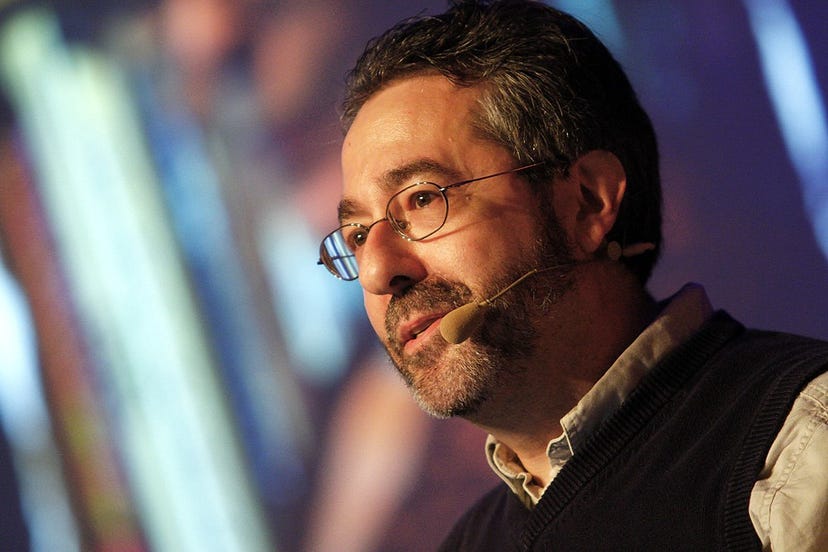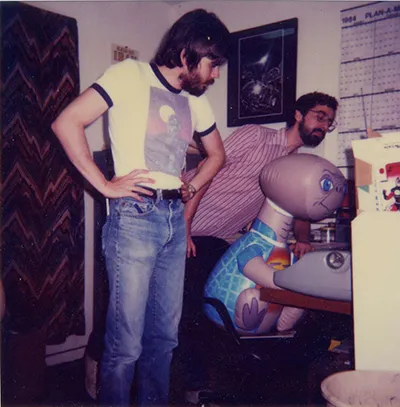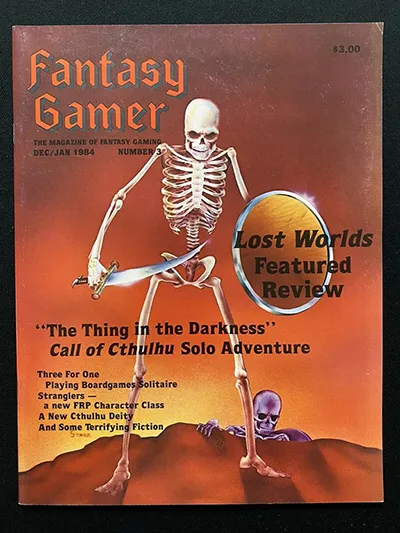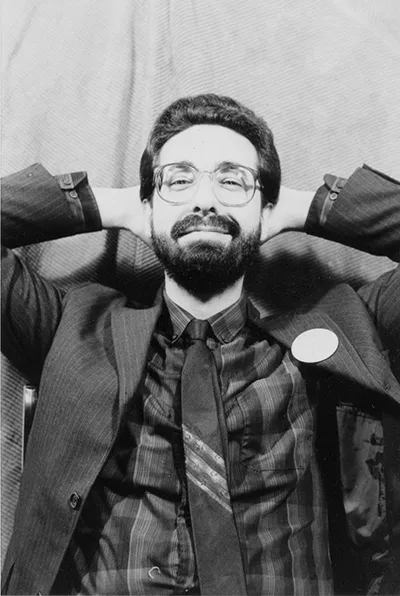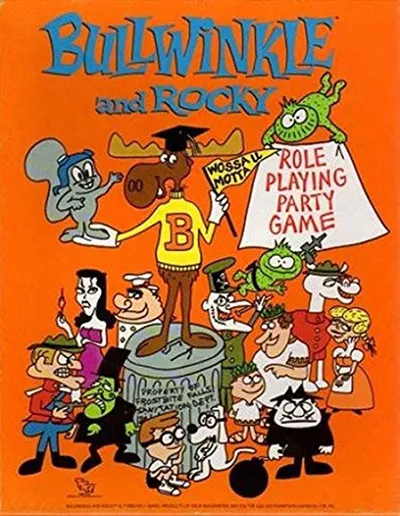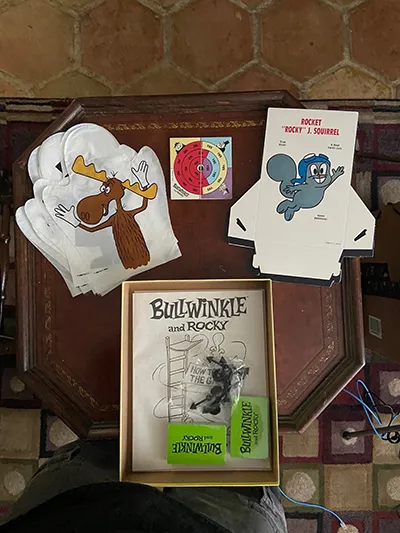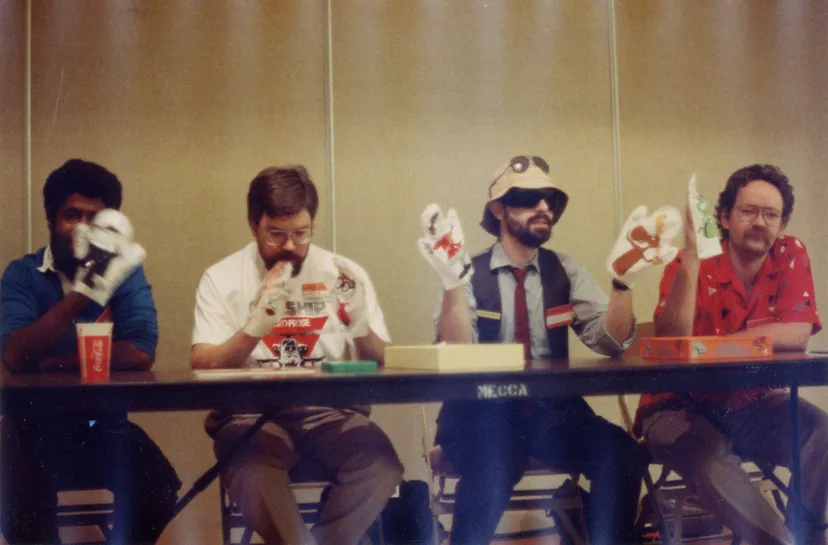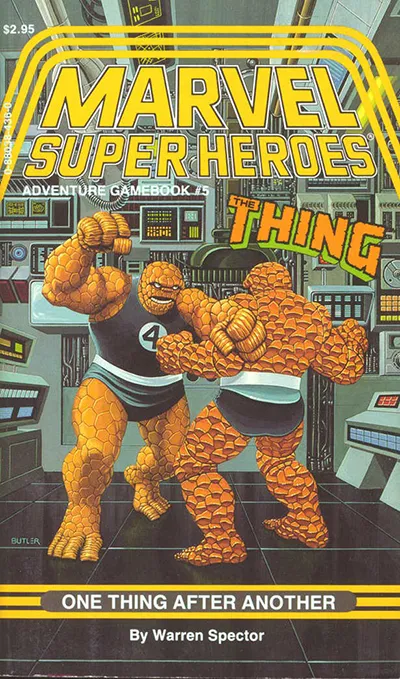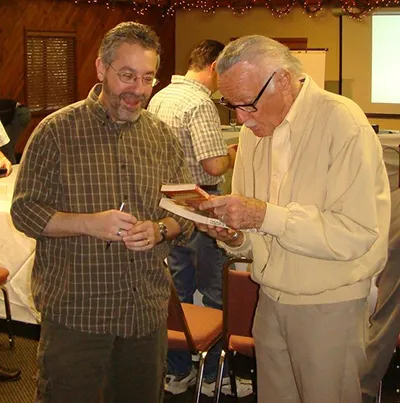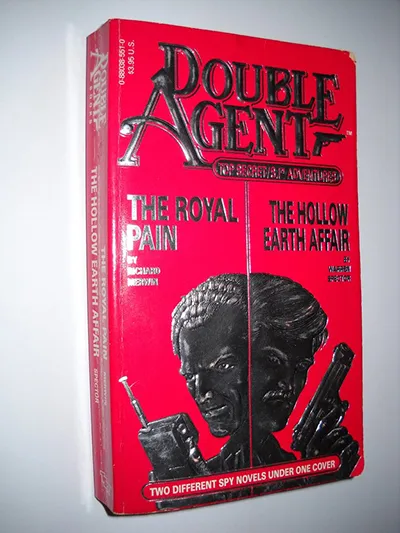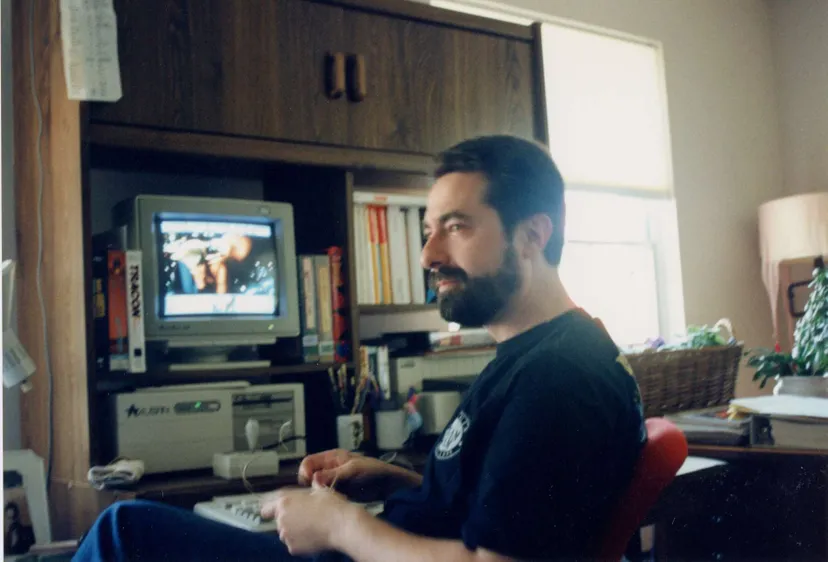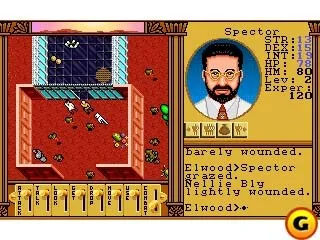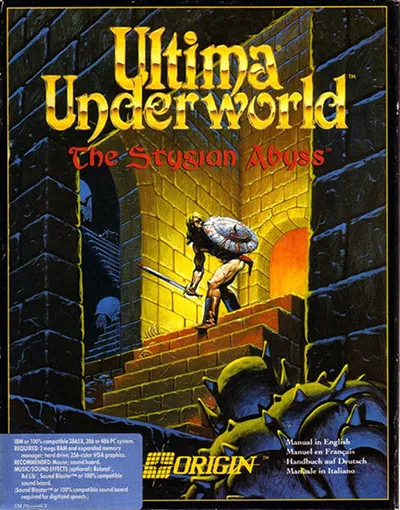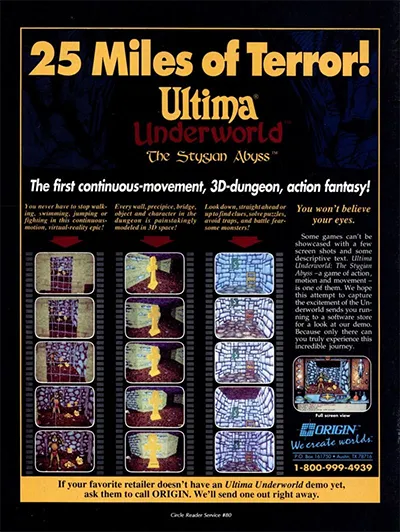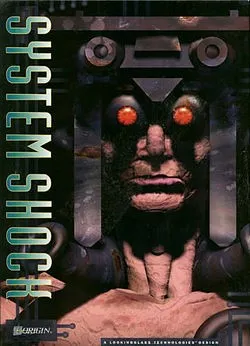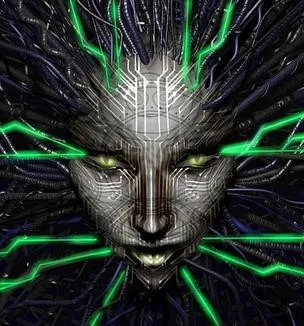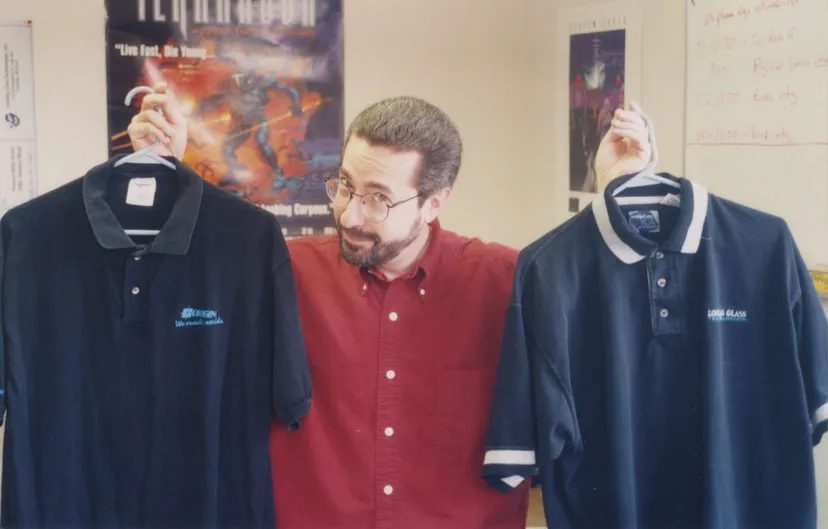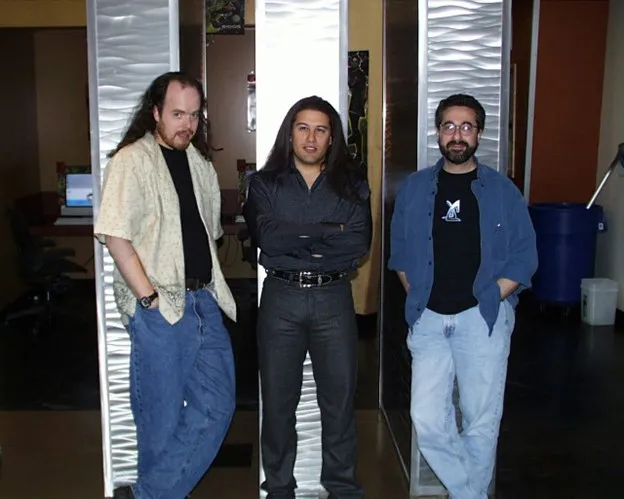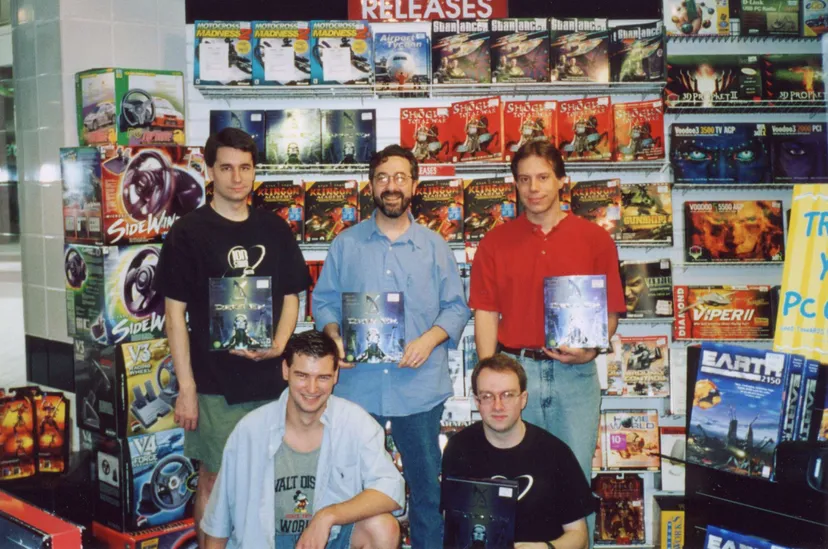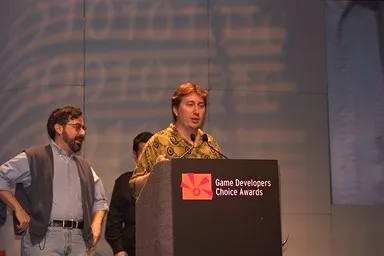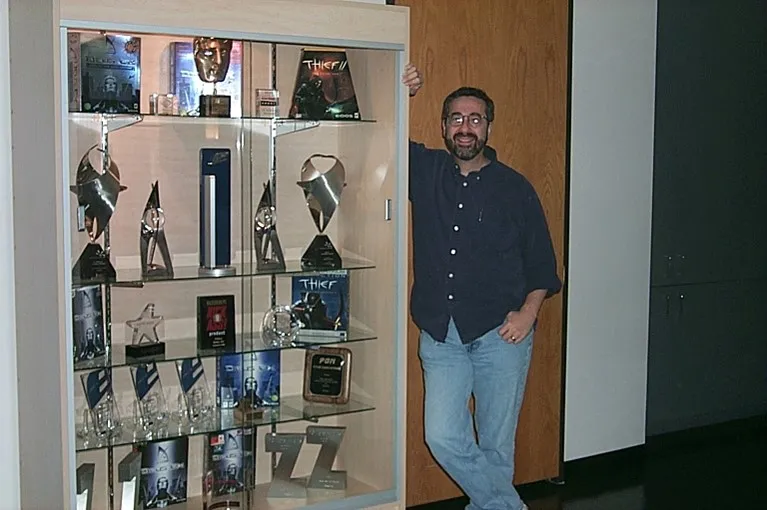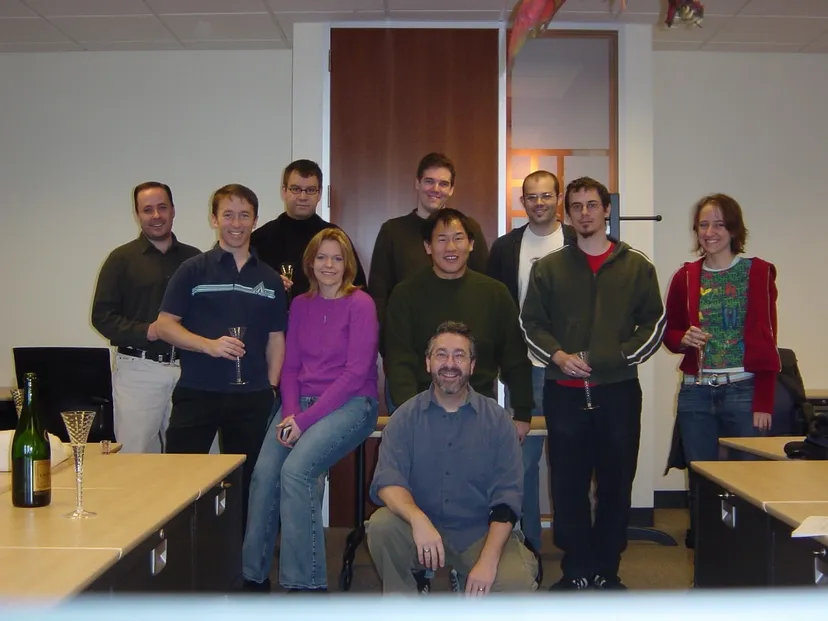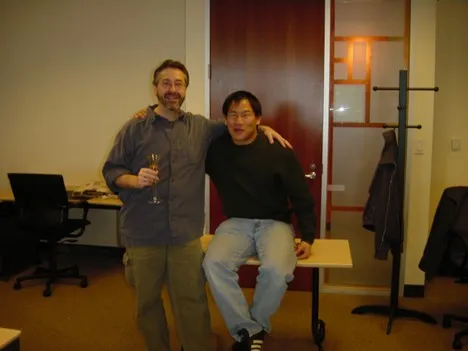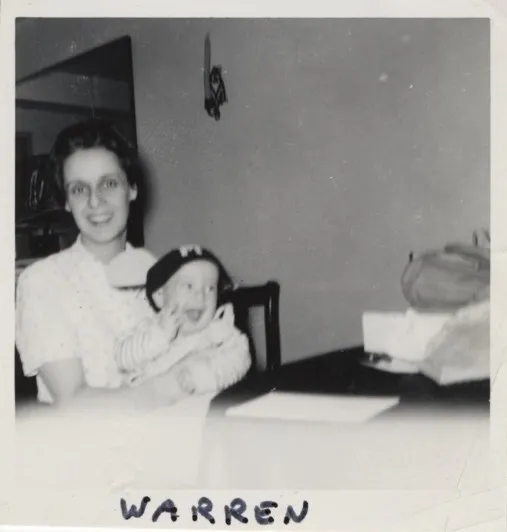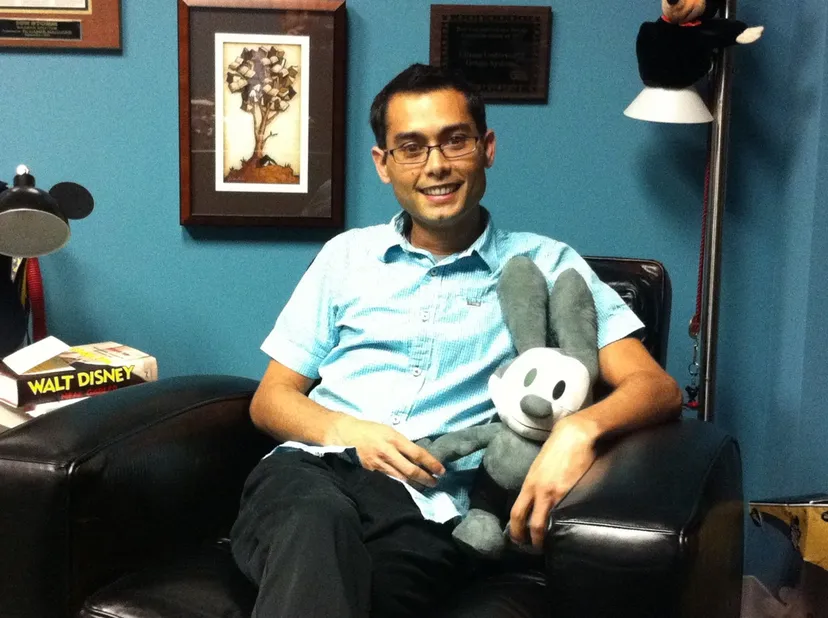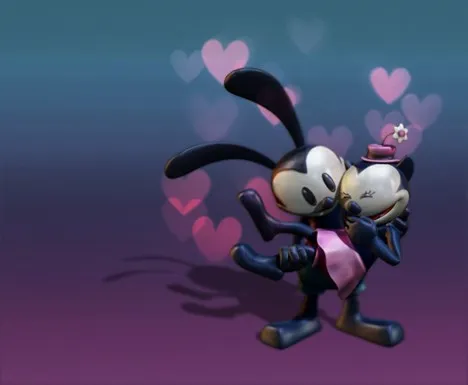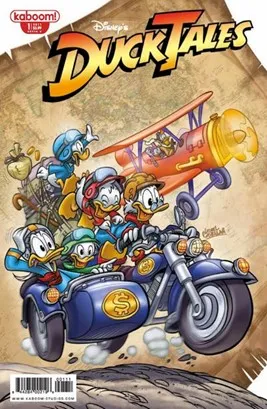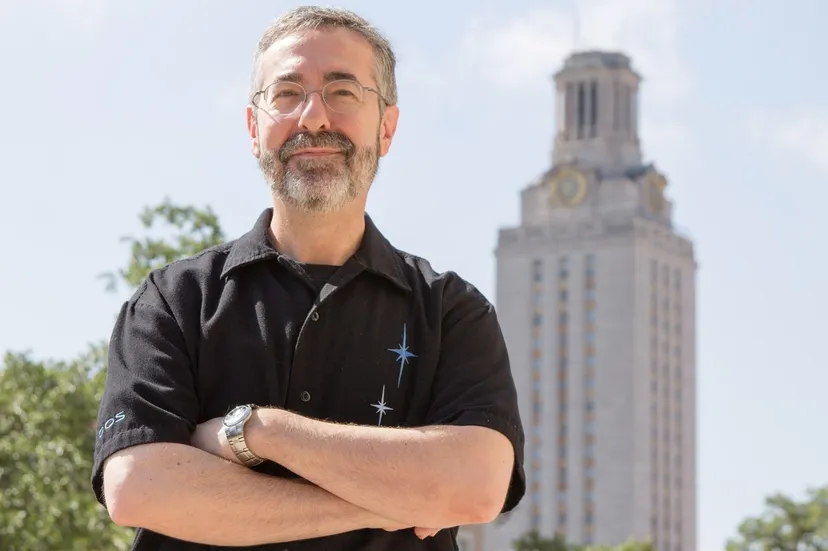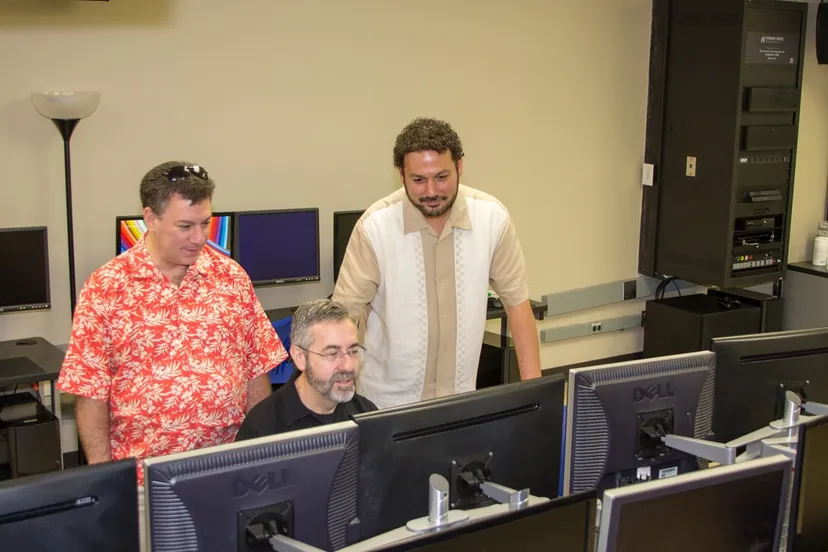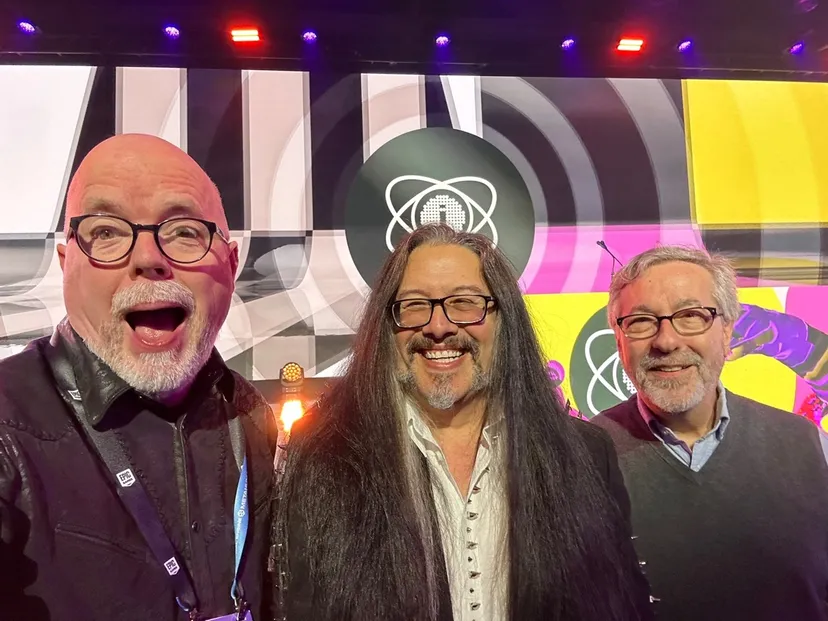40 years and I'm still here
Looking back at a long and fortunate career in game development.
Warren Spector
September 26, 2023
To my amazement, this month - September 2023 - marks my 40th year in game development. I’m not sure how I’ve survived so long in a business that more typically burns people out in... somewhat less, let’s just say. That said, I have some thoughts about survival and an urge to tell the story of how I today find myself one of the most long-lived veterans still actively involved in making games. There may be a few older geezers still working, I guess, but most of you who want to chime in with an arthritic “But I’ve been doing this longer than you” or “You’re a young whipper-snapper next to me” are probably big deals on the business side - C-suite types. If you’ve worked more than 40 years and are still actually working with teams to make games, let me know. We can hang out and talk about our lumbago.
But now I’m just bragging.
So, I want to share my story. And I want to talk about how things have changed and about how they haven’t. Don’t expect any deep design or creative leadership insights here. I’m going full selfish on you and talking about myself. (Hey, if Cliffy B and John Romero can write their - fascinating - autobiographies, a blog post from me can't hurt.) Maybe you’ll find what I have to say interesting, maybe not. One of the joys of aging is that you kind of stop caring what other people think, so I’m just going to ramble on. You can join me if you want. Or go read someone else's blog. I won't be offended.
My story
I discovered Dungeons & Dragons back in 1978, just four years after the game made its debut. I bought the white box edition - the one that required players to make up half the rules, a bit of design genius if there ever was one. I mean, once you'd made up a bunch of rules and made the game your own, who was going to give it up for some other set of (possibly better) rules? Modern TTRPG designers may want to take note.
Anyway, prior to the D&D revelation, I was an obsessive player of little-cardboard-square boardgames with a writer friend of mine - Walton Simons. (The name may sound familiar to Deus Ex fans.) Some of those games came in ziplock bags from a company called Metagames and later from Steve Jackson Games (important to the story later). Walton - better known as "Bud" invited me to play in a D&D game whose Dungeonmaster was an SF writer named Bruce Sterling, before his first publication and before he became one of the fathers of the cyberpunk movement. I played in that campaign for about ten years and if I tell you how it ended I'll end of crying so you'll have to use your imaginations. Let's just say my fellow party members and I started as lowly troublemakers, the Rat Gang, and ended up political, military and individual powers in the river city of Shang. (This was long before TSR came out with Oriental Adventures. See earlier reference to "writing rules to make the game your own.) I played in a bunch of other campaigns as well, but Bruce’s is the one I’ll always remember.
My personal favorite game was Chill from Pacesetter games, but eventually I created my own set of rules, for a World War 2 RPG. I ran that campaign - about what would have happened in Poland if Nazi occult beliefs were true - for a while before my life changed completely. (As a note, even that Nazi occult stuff was based-in reality as someone saw it, one of the core tenets of the rest of the tabletop RPG's and every digital game I've worked on since.)
That was the context and only qualification for getting my first professional job in game development. I was a game nerd. I was also a film nerd, working on my PhD at The University of Texas where, as part of that program, I was teaching film history, theory and criticism when the department asked me to give up those classes and help another grad student learn how to teach one of them. I had no idea how I was going to pay my rent.
Steve Jackson Games
That was when I got a call out of the blue from a gaming friend who was working at Steve Jackson Games asking if I was interested in an Associate Game Editor at Steve Jackson Games, a small developer of tabletop games in my hometown of Austin, Texas. They were looking for a developer on the game side and an editor for Space Gamer and Fantasy Gamer magazines. That was in 1983. The year I dropped out of the PhD program I was in, just a dissertation short of a Doctorate, to make games. My mom cried for ten years. Given the hijinks at the company that might have been justified.
Steve Jackson, me and a surprise guest editor
I worked on a lot of games at SJG, but the two things that were most noteworthy were Thing in the Darkness and TOON: The Cartoon Roleplaying (both released in 1984). Thing in the Darkness was a solo adventure by Matthew J. Costello which Steve felt needed editing and development. Steve assigned me to do that, but I had no experience flowcharting and revising choose your own adventures and no idea how to do it. Magazine editing I had nailed - I'd done that editing an entertainment magazine insert in The Daily Texan newspaper. Developing a solo adventure? I was clueless. Steve Jackson stepped in and gave me a lesson I needed and will never forget. The Thing in the Darkness appeared on the cover of Fantasy Gamer #3 and was received well. Success!
Thing in the Darkness – the first published game I worked on (all credit to Matthew J. Costello for a fine foundation and Steve Jackson for giving me an education in flowcharting!)
TOON was, to this day, a high point in my career. I've always been a cartoon freak and when I saw TOON on a stack of games submitted for magazine publication, I knew we had something special. It was designed by a guy named Greg Costikyan, a well-known, super-talented tabletop designer. (Weirdly, he and I went to the same high school, though we didn't know each other. There must have been something in the water at that school!)
TOON playtest. That’s Allen Varney on the left and Caroline Chase (soon to be Caroline Spector) on the right. If you’re laughing when you playtest a cartoon RPG you’re doing something right.
Two things struck me about TOON in its original form - it was way too cool to be relegated to magazine publication and it was written in what was called SPI case format. (The latter was the geekiest, dullest albeit maximally effective way of writing rules.) I went to Steve and asked him to let me develop the TOON rules into something simpler and more appropriate to the subject matter. To his credit he told me to run with it. I enlisted the aid of another designer, Allen Varney, who was a great collaborator and deserves more credit for TOON's success than he gets. The game debuted at GENCON IN 1984 - the same day as West End Games' game, Paranoia. The competition for funniest game was on! Both teams won. I never again heard as much laughter at a GENCON. What I'll say is that TOON is still for sale 40 years after Allen and I worked on it. We did something right!
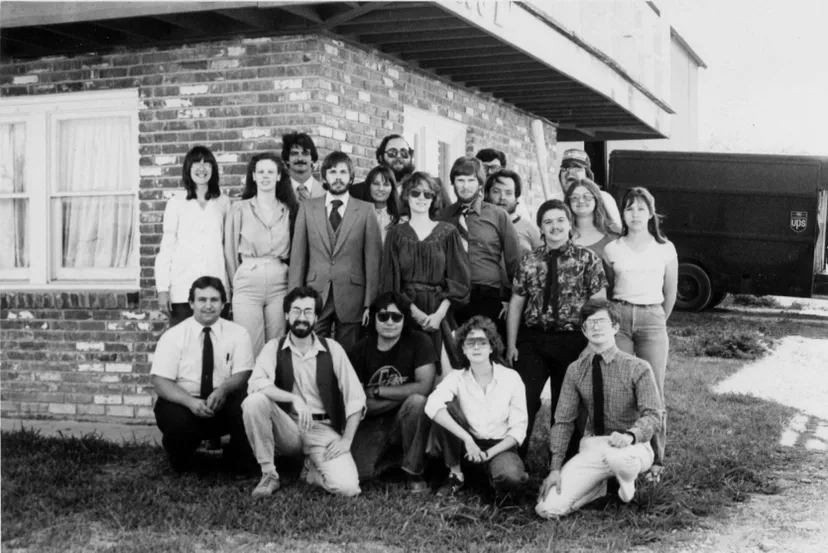
The SJG crew in the early-80s. That’s me in the vest. My future wife, Caroline, is second from the right. Frequent collaborator, Allen Varney is far right. Steve Jackson is in the jacket and tie in the second row.
Three years into my tenure as Steve Jackson Games’ Editor-in-Chief (I got promoted!) I got a call out of the blue from someone at TSR. They made me the Godfather offer - $25,000 a year! – so I moved to Lake Geneva, home of D&D.
TSR
At the time, D&D was perceived in the game development world as yesterday’s news, so bound up with what Gary Gygax and Dave Arneson had come up with they hadn’t innovated in years. Frankly, I thought it was a design problem, that they needed fresh blood, people who wanted to do new things. What I found was something completely different – the design talent up there was prodigious and, frankly, more ambitious than they were allowed to be by the folks in the C-suite. Looking back, you have to understand the executive viewpoint - I mean, would
you mess with D&D, the most successful TTRPG on the planet? Well, I would, but no one would mistake me for a business-first sort of guy.
Early in my tenure at TSR. Smug bastard, eh? If you can’t read it, the button says “For this we came all the way from Texas?” It was a reference to the weather, not the company!
At TSR, I worked as a developer, editor or designer on a bunch of games and modules. I was also Manager of the Game Division for a while, working under a talented designer and all-around great guy, Jim Ward. But that was less interesting and fun than working on games! Notably, I worked with Doug Niles on the Top Secret/S.I. RPG (1987), with Jeff Grubb on the Buck Rogers: Battle for the 25th Century Boardgame (1988), and with Zeb Cook on The Bullwinkle & Rocky Party Roleplaying Game (1988). The first of those was well-received and to this day I think the mechanics were really innovative and still relevant. The Buck Rogers game was definitely not received well! I'll defend it to the end – it was a ton of fun and with greater "toy value" than most games at the time.
I honestly don’t remember if the Bullwinkle and Rockey game attracted any attention at all, but it was for sure zany to the max – hand puppets, spinners, storytelling cards, fake diplomas from Wossamotta U. We tested with all players of all ages, from 7 to 70, and it really did appeal to kids and adults.
Right up there with TOON for the zaniest game I ever worked on!
And here’s why – Cartoony rules, spineers, hand puppets, and more
Designers at GenCon 1988 playing with Bullwinkle & Rocky stuff. That’s Mike Pondsmith (yes, the Cyberpunk guy!), Lawrence Schick, me, and Zeb Cook, from left to right.
These projects were early lessons for me that sales aren't the only success criterion (though it's obviously a hugely important one!). I also got to work on the 2nd Edition AD&D Dungeonmasters Guide, which was kind of cool, to say the least, but it shipped after I left.
And speaking of leaving...
By late 1988, I had started thinking it might be time to move on. It was cool that I got to write a novel (The Hollow Earth Affair) and a Marvel Superheroes solo book (One Thing After Another) featuring the Thing from the Fantastic Four. It was a thrill getting to type “It’s clobbering’ time!” and years later I even got Stan Lee to autograph a copy. Still, I was feeling like the biggest decision I had to make in my job was whether to use percentile dice or D20s. Let’s just say that wasn’t the most fulfilling thing about game design.
My solo adventure featuring The Thing and the Fantastic Four
.
And here's Stan the Man autographing a copy of One Thing After Another. I could barely speak. Stan Lee changed my life!
My one published novel, part of a two-book combo. It’s said that everyone has a novel that should stay in a closet and never get published. This was mine. But it was fun as hell to write.
At that time, I figured there were two logical career paths – become a Disney Imagineer or get into computer games, which I was playing obsessively. I talked to some folks at Disney on the phone, but that didn’t lead anywhere. Probably for the best, as it turned out. See, I had never worked on a theme park attraction, and I was playing computer games like they were going out of style as well as testing the new AD&D digital efforts. I respected the efforts of the folks making those games – they were doing an excellent job of bringing the D&D rules to computers - but I felt that wasn’t the right way to approach things. The
feeling of playing D&D was what was important, not the rules. The games I loved the most were the ones that felt right which, at the time, meant the Ultima games made by Richard Garriott and his teams at Origin. Their motto was "We Create Worlds" and they lived up to it. They were getting closer than anyone else to making me feel like I was playing D&D, a game defined by telling stories
with an author (or Dungeonmaster) rather than being
told a story by that person.
It was a low point for me, but I got lucky again and, in 1988, got a call from someone I'd worked with at Steve Jackson Games who was now at Origin. One day he called me up and said Origin was looking for an Associate Producer and asked if I was interested. That was easy! YES! The opportunity to work with Richard Garriott, the guy who made the early Ultima games and led teams to create later ones, was too enticing to say no to. Richard got it. He saw everything I wanted games to be (within the limits of then current technology).
I got the job.
Origin
It was 1989 and the first things I was assigned to work on at Origin were Ultima VI, Richard's latest project, and Paul Neurath's Space Rogue.
Paul probably doesn't even remember this, but he asked me to work on the plot and flowchart missions. I did that. He junked everything I did and redid it all himself. Probably the right call. I was pretty green and even though I thought “I’m going to teach these computer guys what interactivity is all about” I quickly realized I knew nothing! I had to forget a lot of what I had learned in the tabletop world and learn to exercise some new muscles. Space Rogue was part of my design fitness program. It’s worth noting here that Space Rogue (1989) is an under-appreciated game that ought to be better known than it is. It consisted of first-person space combat, mashed up with an RPG, mashed up with a really fun arcade game. That idea of genre mashup appealed to me. A lot. And I've used that as the foundation of many of my later games. I owe that to Paul.
But at the time, I had more success working with Richard. He and I spent weeks crafting the story, the characters, the quests, and the puzzles for what became Ultima VI (1990). I learned his techniques and his philosophy of what games could and should be. Quite the education. And quite the game. Still one of my favorite Ultimas. Heck, one of my favorite games, even if I did work on it.
I worked on a bunch of other things at Origin, notably Chris Roberts' magnum opus, Wing Commander (1990). That project was a result of a unique vision, a dedicated team and Chris' unwillingness to compromise. I mean, I figured if I had ten arguments with Chris in a day and won three of them, that was a very good day indeed. (I could talk about Wing Commander all day, but that'd fill a book and I'm not writing a book here!)
Testing Wing Commander at home. Work was pretty all-consuming back then!
I worked on other games as well – Martian Dreams, Serpent Isle, Wings of Glory… a bunch of stuff. . I’m especially proud of Martian Dreams, an Ultima-engine game even if no one remembers it even came out.
In Savage Empire I was the evil Dr. Spector. In Martian Dreams I was the no-longer-evil-Dr. Spector, the Avatar’s friend. I swear I didn’t ask to be a character in the games – the teams insisted on it.
One game I worked on was particularly special: Ultima Underworld, made by Blue Sky Productions, founded by Paul Neurath who once again entered my life and pushed me further on the path I'm still on today.
My first encounter with Ultima Underworld came even before Underworld was Underworld. Paul Neurath showed up with a real-time, fully-textured, first-person tech demo - just a demo! I can't speak for anyone else, but all I could think as I watched it was "The world just changed." I saw the opportunity to let players see a world through their own eyes, to be immersed in it, to believe - at least a little - that it was
them in the world, not some squidgy puppet they moved around the screen. I went to my boss immediately and begged him to let me work on the game Paul was proposing, but he gave it to another guy! Luckily for me, that other guy left the company a while later. I begged again and this time, I got it. I got to work on Ultima Underworld (1992).
Denis Loubet’s Underworld box art remains one my favorites to this day. It captures perfectly the feeling of exploration and danger embodied by the game.
The first ad we did for Ultima Underworld was strange – we had to explain what a first-person, real-time game was. No one back then knew. I’m not sure the ad did its job, but it was certainly... strange.
Working with Paul was great, of course, but the real revelation was meeting Doug Church. To this day, Doug is one of the smartest, most talented, most creative programmer/designers I've ever met. A true Secret Master of Gaming if there ever was one. He led the charge on the project in a way he's never credited for having done. And what a team. It was a bunch of MIT-types - even the non-MIT grads and non-grads were MIT-types in my mind! I don't believe there was anyone on the project who had ever worked on a game before. They had no idea what was and wasn't possible, which was key to their success. And, man, were they smart! A bunch of them lived together in a house they called "Deco Morono" - House of Ten Dumb Guys. Right... The first time I set foot in the place, I realized I was the dumbest guy in the room. It was awesome. The game, when it was released, was unlike anything anyone had ever seen. It attempted to empower players in ways that were unexpected and powerful, laying the groundwork for Immersive Sims to come.
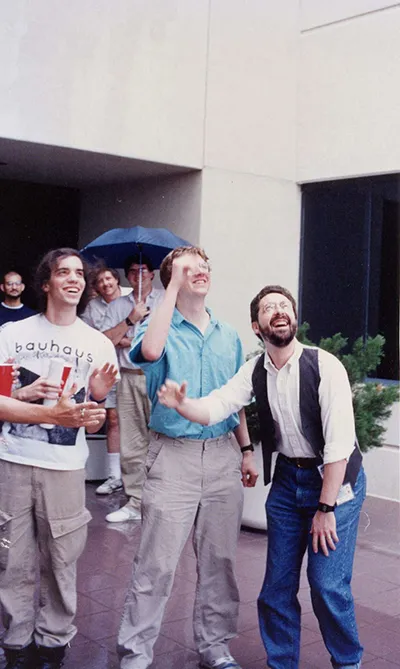
The day we shipped Ultima Underworld. That’s Doug Church on the left, Paul Neurath in the middle, and me on the right. (We were launching a toy soldier into the air to celebrate. Don’t ask me why.)
Speaking of Sims-to-come, after Underworld and Underworld 2, it was on to System Shock (1994). I'm sure everyone has their own story of how that game came to be and my memory may be faulty, but here's what I remember... I was at Origin, bored to death of making games about heroes in chainmail or plate, looking like the Mighty Thor, saving princesses and slaying evil mages. I'd worked with Chris Roberts on the original Wing Commander game and decided I could take the ideas behind Underworld and make a science fiction game, set in the Wing Commander universe. I called it Alien Commander. I wrote up a concept doc and got ready to pitch it. What I didn't know was that at Looking Glass Technologies, Doug Church (there he is again...) was working on an SF game of his own. Knowing Paul, I'm sure he was involved, too, but it was Doug I was talking to. We compared notes and all I could think was, "Um... Yeah... That's better than Alien Commander." Paul was able to assemble yet another amazing team to work on the game. He has a knack for building teams...
The game was cyberpunk to the max, with an engine more powerful than Underworld, with a ton of physics going on. And the plot was, well, good. That was in large part thanks to the participation of Austin Grossman, with whom I've had the pleasure of working many times since. (If you want to know something of what it was like at LG, check out his novel, YOU.)
Even the System Shock box spoke of disasters awaiting us in a horrific future of man/machine hybrids and machines run amok.
The System Shock narrative was communicated in a new way - through videologs and messages from dead folks - everyone was dead on Citadel Station, largely because all existing conversation systems sucked (which they still do). But there was more to the story, as it were. System Shock communicated story through elements in the level - signage, dead body placement, messages scrawled (usually in blood) on the walls. I hesitate to say it, but Shock may have introduced environmental storytelling to gaming.
SHODAN, mad AI. Not that anything like that would ever happen...
In addition, the game featured a mad computer, SHODAN, who's still considered one of the great game villains of all time. The player character had no name - they were just Hacker - so players could create their character based on their own choices and imagination. And D&D-like character stats didn’t matter, either. Shock was all about you, in the world, alone and underpowered to deal with an enemy that was smart and knew exactly what you were up to (or seemed to…) Players had some choices to make about how to play – not just what weapon to use to headshot that zombie. But there was more to come on that score.
I left Origin and officially joined Looking Glass in 1996. Paul Neurath offered me the opportunity to build my own studio in Austin, Texas. That was too good an opportunity to pass up, so after due consideration, I made the leap.
Leaving Origin wasn’t easy, but the opportunity to build a studio from scratch made the difference.
And then there was Thief (1998). A lot of people give me credit for having “made” that game. Leaving aside that no one person can be said to have made or created any game, let me clarify here and now that I worked on Thief for the middle year of a basically three-year development cycle. I’m proud to have been a part of it and hope I contributed something, but let’s cut out the “created by” stuff. Doug and I guy named Greg Lopiccolo led the Thief team to glory, not me.
NOT MY GAME! I WORKED ON IT FOR A WHILE. I’M PROUD OF MY CONTRIBUTION. BUT I DIDN’T “CREATE” IT!
Okay, that out of the way, there was one critical thing that came out of my involvement in Thief. There was a point where I just found an encounter too tough to sneak past, so I went to some folks in the team and said, “Just let me fight my way past things that are too hard for me.” They looked at me like I was crazy and said, “If we make the player powerful enough to fight, no one will ever sneak.” Of course, they were right for Thief. It’s a jewel of a game, tightly focused and beautifully designed. There’s a reason why it’s still cited as one of the best – maybe
the best – stealth games ever made. At the time, though, what went through my head was, “I’ll show them. I’ll make a game where you can decide for yourself whether to fight or sneak past any problem.
Well, there came a point in 1997 where Boston-based Looking Glass was running short of funds and my Austin, Texas studio was the obvious place to make cuts. I remember telling Paul Neurath to shut us down. I mean, shutting down the mothership didn’t make sense. “I’ll find another deal. We’ll be okay.” That’s what I said. Arrogant? I guess. But I was pretty confident. I had a strong team and knew what game I was going to pitch. That was the point when I dug up a proposal I’d written up in 1995 – a pitch for a game called “Troubleshooter.”
Ion Storm
Troubleshooter was an attempt to make what I called “the real-world roleplaying game.” The main character was Jake Shooter, ex-CIA operative who the agency came to when they had a case too tough – or too shady – to handle themselves. The gameplay was, well, play Deus Ex and you’ll see. Problem was the real-world part of the plan. See, people know how the real world works – telephones and televisions and cars and everything else are well-understood and people have expectations of how they’ll behave. At the time – even today, I’d argue – we can’t live up to people’s expectations and the last thing you want to do in a game is thwart players expectations. The answer was to move the game into the near future – recognizable but far enough out that players couldn’t say, “That’s not the way a computer works!”
Then there was another consideration. Cool as a noir-like private investigator/spy could have been, it would have been about as silly as another space marine or knight in shining armor. And the kinds of situations the player would find themselves in might be thrilling, but a million other games had the spy/military thing covered. I knew we had to do something different. Cutting to the chase, that “different” looked like it was going to be an RPG variant of Command & Conquer. Talk about cool! I would have done that in a heartbeat if John Romero hadn’t called me and offered me the opportunity of a life-time.
Another lucky break! My life’s been full of them.
John drove down to Austin from Dallas and said “Make the game of your dreams. Biggest budget you’ve ever had. Biggest marketing budget you’ve ever had. And no creative interference.” Who the hell says no to that?! I sure as hell wasn’t about to. So we joined Ion Storm, with Eidos as our publisher. Both were great. Both lived up to every promise John made. I owe John a huge debt. I’ll never be able to repay it, but I hope our friendship and mutual respect is enough.
What a bunch of reprobates! Tom Hall, John Romero, and me. Ion Storm in 1999.
But back to the story. We were set, deal-wise, but the remnants of my old Looking Glass team and I still knew our world-building needed work. One of the things I’m committed to is finding things people already care about rather than trying to
make them care about something. So the team and I started looking around at what normal humans – not just gamers – were thinking and talking about. What we found was that Y2K was on people’s minds. The rise of AI. Terrorism. Human augmentation. Bioengineering. Unequal distribution of wealth. And there were so many conspiracy theories flying around in the cultural ether you could swat ‘em with a baseball bat with no fear of striking out. Those things would be the heart of our world. (Heck, you could make a game about all that today and it would
still work. Which is kind of pathetic…) And, not to get too far ahead of myself, one of our rules was that nothing went into the game unless you could point to the real-world reference for it. We even got blueprints, maps and, of course, photographs of places and tools and so on.
Anyway, we had the foundation of a world and a clue about what the game was about. I knew I wanted to show those Thief guys that you could make a game that gave players choices about how to solve problems. The game had to be about how clever and creative players were, not how clever and creative we, as developers, were. I needed the right team, folks who bought into the world and the gameplay concept. I found them. I could talk about every person on the team but I’m going to risk alienating people and just mention three – Harvey Smith, the game’s Lead Designer, Chris Norden, the Lead Programmer (and later my Assistant Director) and Sheldon Pacotti, our Lead Narrative Designer. Talk about people who get too little credit!
Chris was a terrific coder who totally bought into the plan. He was what I call “the guy who told me ‘no.’” I’m kind of a kitchen sink guy and often need to be told to back off. More than anyone else, Chris was never shy about doing that. That said, he had an interesting “tell” when we talked that said “yes.” If I asked for something and Chris said “no,” a lot of the time I knew I’d see it working in a couple of weeks. Heck, sometimes the next day! To say he could make things happen would be an understatement.
And Harvey. What can I say about the guy? I knew he was special even when he was a tester on System Shock. I remember some great design conversations we had late in the night at Origin! He got the Imm Sim thing even then. I knew I needed him on Deus Ex, took him out to dinner, plied him with guacamole and told him what I wanted to do. Happily, he signed on. There’s a lot more I could say, but I’ll just leave it at this – Harvey was a natural-born design team leader and a critical leader overall whose contributions to Deus Ex were huge and under-appreciated.
Finally, Sheldon. I wanted him on the team from the minute I read the short stories he submitted when he applied for the narrative job. Terrific writer and super smart. People often talk about how “intelligent” a game Deus Ex is. Lots of people contributed to that – as a team we were committed to it – but Sheldon was The Man when it came to ensuring that our plot, NPCs, dialogue and in-game texts were smarter than a lot of other games. (As a note, I’m really proud of the “smartness” of DX. The name refers to Deus Ex Machina which in literary terms describes a bad narrative approach – look it up. It was also called that because the game was at least in part about the potential and peril of AI, of machines that become sentient – Deus Ex Machina... God from the Machine... get it? Plus, I thought it would be funny if people mispronounced it and had to say “sex.” That last one proves that I’m kind of a nitwit at times! And I will never give a game a name that players can’t pronounce. I’m sure embarrassment cost us some sales!

The incredible Deus Ex team. One of the best. And, yes, it was that small. That’s Chris Norden on the far left, Harvey next to him and Sheldon on the far right in the second row. Wish I could name them all, but this is long enough already!
Anyway, there’s a lot more to say about Deus Ex, but I’ll leave it at this: When we were getting ready to ship, I put my head down on my desk and thought, “If people compare our combat to Half-Life, we’re dead; if they compare us to Thief’s stealth, we’re dead; if they compare our RPG elements to Bioware’s latest, we’re dead. But if they get that they can
decide how to play, to do
any of those they want, we might rule the world.” I’ll leave it to others to decide which of those describes the finished product, but I’m pretty proud of the result.
Deus Ex was released in 2000. People liked it pretty well. As important, we on the team liked it. It was definitely a high point in my career and, I hope, in the careers of the team that made it possible and, well, made it!
Deus Ex launch day. Yeah we were in a thing called a “software store.” Some of you may remember those...
Harvey at the mic, me playing Superman behind him when Deus Ex won some awards at the Game Developers Conference.
Oh, one last thing. At the time, it was science fiction and people took it as such. I’ve said this before, but I’m not sure I’d make a game like Deus Ex today. Too many people would see it as a documentary. Did I say “pathetic” before. Yep. I did. Now, the idea that games should empower players and give them agency to tell their own stories? That I will always do. But the world and the narrative? Nope. Too dangerous in a world where the things we said about the world in Deus Ex have become our everyday reality. No. I’m not going there. Plus I have other interests and I’m going to indulge them as long as people will continue to fund me.
After Deus Ex, Ion Storm Austin did some sequels – Deus Ex: Invisible War (2003) and Thief: Deadly Shadows (2004). There are plenty of stories to tell about those, but the critical thing for me is that I’m not much of a sequel guy and so in 2005 I decided to leave the studio and do a start-up: Junction Point.
One of the awards cases from Origin, Looking Glass and Ion Storm days. And yeah, I’m bragging. Wanna make something of it?
Junction Point
Junction Point got started in 2004 by a small group of Ion Storm folks, who like me, were ready for a new challenge.
Junction Point, day one. We started out small, but we had big dreams
Most important was Art Min, my partner. I'm not sure I would have had the nerve to do a start-up myself - I'm pretty sure I would have failed - without him. We had worked together before at a couple of studios on several games and I knew he was a terrific coder and a natural-born leader.
Art Min and me. I wouldn’t – probably couldn’t - have made Junction Point a reality without my partner in crime.
There were a dozen of us and we met at a local Mexican restaurant to plan our new endeavor. But there was one more piece of the puzzle - Seamus Blackley ("father of the Xbox"). He had been a developer of note but at the time we started Junction Point he had left development to be an agent at Creative Artists Agency and I signed on with him to represent me.
Seamus and the other game agents at CAA had a plan to remake the business model in gaming to be more advantageous to developers and it sounded to me like exactly what should happen. I won't go into the details here - that's not my story to tell - but I'll just say it really would have changed things.
Back home, the team and I started in on some new IP and came up with three that showed promise. One was an epic fantasy RPG/Immersive Sim called Sleeping Giants, based on a concept my wife, Caroline Spector, and I had come up with for DC Comics. (They passed...). One was a multiplayer action Imm Sim called Necessary Evil, a multiplayer game about augmented soldiers and independent operatives who could collaborate with or oppose each other, serving the military, businesses or mercenary groups. It was all about what happened when augmented military soldiers mustered out. I still think that’s a cool background for a game. Someone ought to make it so I can play it. The third concept stemmed from Seamus’s fertile imagination. He hooked me up with director, John Woo and together he and I developed an IP called Ninja Gold, designed to be a transmedia thing - movie and game simultaneously, with us collaborating on its creation. That was a trip. I loved working with John and learned a lot about the similarities between movies and games but, more important, some critical differences. That's a blog for another time.
The team got working on Sleeping Giants and Ninja Gold and did some great concepting and prototyping. Maybe I'll post some of the work they did some time. I have some cool docs and cooler videos... Anyway, we had a movie deal for Ninja Gold but no game deal at that time. The movie deal went away when the studio decided on a change of strategic direction. (A term that would come to haunt me later.) We got a game deal for Sleeping Giants. It went away - strategic direction again. We got another deal. (Seamus was good at his job!) That deal went away. I think we got another deal, but I can't really remember. Whether we got a third deal or not, we ended up with no deal. And no way to keep Junction Point alive. Until Valve called.
They offered us a lifeline in the form of a Half-Life 2 episode. Needless to say, I said yes, and the team got to work on yet another project. There's a whole story about that, but this is getting long enough that I'll just say it was set in Ravenholm and the team came up with a thing called the Magnet Gun. (You can imagine what it did.) The MG was unlike anything in the Half-Life arsenal and I thought it was incredibly cool - powerful, open to creative uses, and at times even funny. It took us a long time to master the Half-Life tech and just as we started building what I thought were very cool levels, Valve pulled the plug on us. The timing on that was pretty frustrating.
So in 2006, or thereabouts (my memory’s hazy), I was on the road with Seamus again, pitching three adult, action-oriented, original IP, desperate to keep the studio alive and the staff employed. (Indie studios don't have an easy row to hoe!) I pitched a bunch of publishers and potential funding partners, but didn't have much success. Then one day Seamus said, "Let's pitch Disney."
I thought he was crazy. "They're not going to be interested in any of these concepts," I said. To which he replied, "They've changed. Let's do it."
Oooo...kaaaay....
The day came for the Disney pitch. As I talked about the three concepts, the dozen or so people around the conference room table stopped paying attention and started checking their phones and all that. I was going to kill Seamus when I got out of there. But then the strangest thing happened.
Graham Hopper, who headed up Disney's game division at the time, asked me if I'd be interested in making any licensed games. Here's where you have to understand that I've been a huge Disney fan for... well... forever. I said, "Yeah. Give me The Night Stalker or Ducktales and I'm in." (I had an idea for a monster-of-the-week game that would have been perfect for ABC’s Night Stalker series and I love Carl Barks and Scrooge McDuck.) Graham looked at me and said, "What about Mickey Mouse?"
It took me three seconds to think, "Is he kidding? The most recognizable icon on player Earth?" I said, "Yes!" I have to admit that, with Mickey as my star, I could reach a mainstream audience with the Imm Sim game approach, but I probably would have done anything to work with Mickey.
Graham said, "We have a Mickey concept I'd like to show you. You don't have to use any of it. Just tell us what you think." So Luigi Priore, who's been with Disney forever, pulled up a PowerPoint and pitched a concept dreamed up by some interns. Some very, very creative interns! It had a lot of elements that made it all the way into the shipping Epic Mickey game. Graham reiterated that I didn't have to use any of their pitch but I had a quick reply. "Are you kidding? Why wouldn't I use some of those ideas? You have some pretty creative folks at Disney and that concept is really strong. You've given me an acorn and I want to grow it into an oak tree! I'm in!"
The Interregnum
Seamus negotiated a concept development deal for Epic Mickey. I spent six months in 2006 working with my old TOON design collaborator, Allen Varney, and Alex Duran, a talented programmer, to flesh out the idea. Together we came up with a pitch. (and by “pitch,” I mean a 240-page document and a PowerPoint deck). I went to Disney and they ushered me into a conference room with two doors. I went in one, gave the pitch, and eventually was ushered out the other to discuss things further. I was later told that if I'd been ushered out through the door where I'd entered, that would have meant the pitch was unsuccessful. Luckily, I went out through door number 2 and discussions continued.
After going out the good door, Graham said they wanted to move ahead. Sadly, over sushi, a biz dev guy told me shortly after that the only way I would get to make Epic Mickey was if Disney acquired Junction Point. Stupidly, I guess, I said no. I wasn't ready to sell (and if I’m being honest, the deal just wasn’t that good). Cut to a year later, 2007, and Disney came back and said they still wanted Junction Point to make the game but they still had to acquire the studio. I thought to myself, "How many times is Disney going to come back to me?" I said yes, Seamus negotiated the acquisition, and the deal was done. Almost.
The plan was to announce the deal at E3. The date was set. The time. The room booked. On the day, the press was filing into that room. Unfortunately, I hadn't yet signed the deal! There were a couple of points I wasn't happy with. So there I was outside with Graham who was waving the papers at me waiting for me to sign. I had Seamus on the phone talking me off a cliff. Finally, he just said "Do you want to work with these guys and make this game?” “Yes,” I said. “Then sign the deal" he said. I signed, the announcement went off just a little late, and I officially worked for Disney.
When I went back to the studio, two things happened: First, I called my mother to tell her the news. Her response tickles me to this day. What she said was "It's about time" - not "Congratulations" or "Are you crazy?" Just "It's about time." I told you I was a Disney fan!
My mother and me – was there any doubt I’d end up a Disney fan?
The other thing was I went back to the team built to make adult Imm Sims and said "We're making a Mickey Mouse game." A great level builder and my narrative lead left because they simply didn’t want to make that kind of game. Best decision they could have made, for themselves and the project. If your team isn’t onboard and bought-in, you’re doomed. The rest stuck around because they were Disney fans like me or felt like they could become Disney fans by the end of the project. Which everyone did.
One other thing happened. Paul Weaver, one of the best Creative Producers and studio execs I've ever worked with signed on. We'd worked together at Ion Storm and with him onboard, I felt like Junction Point couldn't fail. I had that much confidence.
Paul Weaver. Production and business powerhouse with substantial creative chops.
Paul brought along a senior designer named Chase Jones. I didn’t know Chase at the time, but he turned out to be one of the most talented designers I've ever worked with, another one of those natural leaders I’m lucky enough to stumble into. I put him in charge of the Epic Mickey design Allen, Alex and some incredibly creative interns had concepted. I functioned as Creative Director, with ultimate authority. (I always reserve one more vote than everyone else on my teams, combined).
Chase Jones. Super-talented designer and team leader. Disney Epic Mickey and the sequel, The Power of Two wouldn’t have happened without him.
At the same time I was keeping an eye on another project I still don't want to talk about. And running the studio. And dealing with Disney. Fun times!
The Epic Mickey story is a long one so I'll glide over that. Suffice to say it was one of the highlights of my career. It took over 300 people, but we got it done and shipped in 2010. I loved its mashup of platformer, shooter, and adventure. I loved that it was what I called an Imm Sim Lite. (Core gamers didn’t get that, which pains me to this day, but normal humans did, which was pretty darn satisfying.)
Among the coolest aspects of my Disney experience was that me team and I got to reintroduce Oswald the Lucky Rabbit to the world. (Oswald was Walt Disney's first cartoon star, lost to him in a 1928 contract dispute with his distributor. And, man, is there a story there – about the contract and about how Disney got the rights to Oswald back. A story for another time.) We got to give Oswald a girlfriend - Ortensia - who everybody at Disney and the world now thinks was part of Oswald's world back in the '20s. She wasn't - we named her... brought her to the screen... in a game... and no one realizes it. I laugh every time I think about that!
Oswald the Lucky Rabbit and Ortensia, his girlfriend.
The first game did well when it was released in 2010, so we did a sequel, with Chase very much in charge, supported by Paul and with some help from me. It took almost 800 people to make Disney Epic Mickey: The Power of Two in 2012, but we introduced a lot of new things, most notably adding multiplayer and Broadway musical-type songs. I've always wanted to make a musical game and this was a baby step in that direction. Someday I'll make a full-on, interactive, Imm Sim musical game that is far more than just beat-matching. I have ideas about how to do it and I will… Soon as someone's crazy enough to fund it.
After that, we started working on an Epic Donald game with the Oliver Twins over in the UK. They and their team did a great job. Concepting was going well. Concept art was spectacular. A prototype showed promise. My first clue that things were going south at Disney was when I pitched the game for continued concepting and the project didn't get greenlit. Sixteen people in a room voted no when they were told by a Marketing guy that data showed that Donald didn't test well. I was seething mad about that conclusion! I didn’t and don’t trust data and research much. Specifically, I felt like they hadn’t tested in Europe and Scandinavia, where the ducks are incredibly popular. And even if it were true that the ducks weren’t popular in the States, didn’t that make it our job to change that and put Donald in a position to test better?
I got to write a series of Ducktales comics despite the demise of Epic Donald! For a Carl Barks fan that was both intimidating and incredible!
But the non-greenlighting of Epic Donald sent us back to the creative and business drawing board.
Paul and I – mostly Paul - worked up dozens of sku plans and budgets, but none of them got approved by the powers that be. (It’s worth pointing out that “the powers that be” no longer included Graham Hopper. He was a guy who actually cared about games not just about business, but he’d been replaced. So kudos to him for having some vision. Whatever the opposite is of kudos go to the folks who replaced him. That’s all I’ll say about that!)
The rest of the Disney-Junction Point story is all business nonsense I'll maybe talk about some other time. The important thing is that Disney shut down Junction Point in 2013. Two hundred people lost their jobs. And after seven years, I was no longer a cast member and, for the first time ever, I was out of work.
The Denius-Sams Gaming Academy
I'm embarrassed to admit I spent several months after the shutdown of Junction Point sitting on a couch with a remote control in my hand watching YouTube videos. My wife finally told me I needed to get up and find something to do. I got lucky
again. A call came in late 2013 from the head of the College of Communication at the University of Texas at Austin asking if I wanted to create a game development program. I’d taught a Master Class in Game Development in 2007, I think it was. (Videos of all the sessions are still on You Tube and I think some of the content is still relevant today.) Anyway, he told me the College had funding for three years and wanted to set up something innovative – a certificate program that would be free for 25 students a year. Yeah, it was a great deal for students and sounded like a fun change of pace to me, so I agreed to a three-year run as leader of whatever program I could sell the University on.
Me in front of the Texas Tower on the University of Texas at Austin campus.
First thing I did was research what all the other university and college game development programs were doing. There were, according to the ESA, 400 institutions of higher learning offering game dev courses or programs. I didn’t see any point duplicating them. What I found was that all of them I could find and research were teaching actual development – the making of games – and often in the context of small, indie-style teams working on very small projects. And I found that many, maybe most, student projects never reached completion. Finishing things is one of the hallmarks of professionalism. I’ll blog about that someday. (Before any educators start berating me, that wasn’t universally true, but definitely the predominant strain of games education.)
I knew I wanted to do something different, so I decided to focus on creative and business
leadership as it related to relatively large teams. I wanted my students working to complete two projects during the year – a simple one in the first semester and a more complex one in the second. Each student would have a specialty – just like on a real, studio dev team. There would be leadership lectures in the morning and development work in the afternoon and evening.
My faculty would consist of two folks who had real industry experience and had worked on a mainstream PC or console games recently enough that their experience was still relevant. Too many game dev programs are taught by people who’ve been out of the professional world for too long or have never worked on a game at all. Given how quickly things change in the world of gaming (see below!) either was, let’s just say suboptimal... I found my staff in two excellent developer/teachers – Joshua Howard and D.S. Cohen.
Joshua Howard, me, and D.S. Cohen, instructors at the Denius-Sams Gaming Academy. Here we are preparing to instruct.
We interviewed dozens and dozens of student candidates, as rigorously as if we were hiring a team of our own. We quizzed them on their development skills but also on their leadership potential. We wanted the best of the best, and I think we found them. The success our graduates have achieved speaks to the quality and qualities of our ex-students as much as – more than – our training of them. I can’t tell you how proud I am of them. I’m as interested in making people as I am in making games at this point in my career (though I have no plans to stop doing either!) and working with the Academy students was a great way to scratch that itch.
In any event, I haven’t even gotten to the innovative thing the program offered – the real, hands-on opportunity for each student to take on the creative and business leadership opportunities on the projects. Every two weeks, we created a development duo, one playing what might be called the Creative Director role and the other the Producer role. The staff met with these duos daily to talk about what they were doing well and where they needed to do more work. Everyone got to put into practice the leadership lessons learned in the morning lectures.
You’d have to talk to the students to determine how well the program met their needs and prepared them for the real world, but all four semesters resulted in finished games of high quality. And almost all of the students got real-world jobs and, as I said, went on in most cases to do some pretty impressive things.
I was proud of what we were doing, but mid-way through my three years building and then running the program, I started to feel the itch to get back into development myself. There were still things I wanted to make. As my commitment neared its end, I started thinking about what might come next. I could stay on and be a teacher for the rest of my life. That would have been cool. But I started entertaining the idea of doing a new start-up. I had ideas for games to develop – my One-Block Roleplaying Game... an Interactive Broadway-style musical... An outdoor, multi-player Immersive Sim...
It was 2016 and Paul Neurath entered my life again.
OtherSide
It was one of those magical, out-of-the-blue calls - the kind of call that has changed the trajectory of my life so many times. This time Paul told me he was doing a start-up of his own, had the boring business stuff under control, and asking if I wanted to join him as a co-founder.
Hm. Do a start-up where all the HR and business stuff was already in place? Intriguing. The hook was in the water. Then he baited it.
“I have the rights to make a new Underworld game. And I have the rights to make a new System Shock game. I’m going to make the Underworld game up north. You can make the new Shock game. In Austin” (my hometown).
It was another of those moments – like the Steve Jackson Games job I probably didn’t deserve,,, like the TSR moment... the Origin moment... the Ion Storm moment... the Mickey Mouse moment... It was yet another “Who says no to that?” moment in what’s been a blessed career.
So Paul and I set about building two offices, one in the Boston area, the other in Austin.
The story of System Shock 3 is long and convoluted. Basically, though, I built a team. I had a concept that included a feature no one had ever seen in a game before. We got funding. We worked at it for a while. The business side of the project went kaflooey. Suddenly, I was looking for a new concept and a new team to build it.
I had those three ideas for games to make I mentioned earlier. I picked one - Argos: Riders on the Storm (working title), the one that seemed most obviously the next step for Imm Sims. I could have gone for one of the projects I thought would just be cool, personally. But I’m a relentless advocate for Imm Sims and we’re not done defining that genre. Argos would be a next step.
We’ve built a core team to concept it with me, and prototype it and plan it. That’s really about all I can say right now. Okay, I
will say that the team we’ve built so far is one of the strongest I’ve ever worked with. They have the potential to be a team on par with the best in my career – and I’ve been lucky enough to have worked with some great groups. They constantly come back to me with ideas and approaches to realizing the vision better than I could have imagined (which is exactly what you want from a team!) And the concept is... out there. Even I think it’s a little nuts. But if ...
when... we pull it off... Man,..
In addition to being the Creative Director on Argos, I’m the Chief Creative Officer for OtherSide, which means I get my fingers in every game we put in development. My job as CCO involves two things:
First, to safeguard the studio’s mission. That means empowering players to experiment with deeply interactive worlds and craft their own unique experiences through their play and playstyle choices. In other words, kind of what I’ve tried to do for forty years. Paul Neurath and I are in lockstep on this. No compromises.
Second, it’s my responsibility to help all of our teams, in any way I can, to build the best version of the games they want to make. Tempting as it is to violate this rule, I have to remind myself that it’s
their game, not mine. No compromises there either.
On Argos, I play a central Creative Director role in determining what the game is going to be. But we’re also making another game, Thick as Thieves, which has its own team, its own leaders, and a somewhat different approach to realizing the company mission. Like Argos, and as every game should, Thick as Thieves has some elements that I think will surprise and please players. There’s a great leadership team in place and the rest of the team is strong. I can’t say anything more yet. Sit tight.
In 2023, OtherSide was acquired by a new company called Aonic. It’s early days, but I’m psyched to be a part of their family and I’m looking forward to seeing where our partnership goes. The future looks bright.
Ch...ch...ch...changes
So I survived 40 years. What's changed in that time? It really is tempting to go with the cliche “everything.” And there's some truth to that:
For starters, I have a lot more gray hair. But that’s significant only to me. There are plenty of genuinely important changes to talk about.
Remember that picture earlier of the three reprobate designers at Ion Storm? Here we are in 2023 at the ceremony where John Romero got his well-deserved Lifetime Achievement Award at GDC. That’s Tom Hall on the left, then John, then me.
When I started, we had nothing, conceptually, development-wise, technologically or tools. There were no game engines to make life easier. There weren't even any existing genres to borrow from and guide feature development. There were no sound cards. (One major sound card company told us they owed their survival to the first Wing Commander game...) Hell, when I started, we had one color - green - and got way too excited when CGA came along! We were making it up as we went along. which was pretty exciting, let me tell you. That feeling of creating something – an entire medium, not just a single game, was pretty thrilling.
There was no E3 show. And the game space at CES was silent as a tomb. Until one year, Chris Roberts rented what passed for a big-screen TV and a movie theater sound system to demo Wing Commander. Let’s just say the folks in charge of the show came by to make us turn the volume down! We ignored them. You can blame Chris and Origin for the hearing-damaging volume levels at game conventions!
Selling 100,000 copies of a game was called "going gold" and when that happened you went and bought yourself a Ferrari.
There was no digital distribution or online and multiplayer gaming. We sold in baggies or boxes filled with disks. The first time we shipped a game you could install on a 10-megabyte hard drive, we said "No one has a hard drive that big - we'll have to ship the game with a drive in the box. And the first time we saw a CD - a CD mind you - we stared at it like apes seeing the monolith in 2001 and said "no one will ever fill one of these up." (We were wrong about that, by the way.)
We actually depended on these things called "magazines" for reviews and PR.
We posted fan letters... on paper... some of them handwritten... on office walls.
The 3D revolution hadn't even begun. There were no games that featured 3D modeling - some of us spoke at SIGGRAPH about the 3D revolution in games even as we were in the midst of that revolution. And speaking of 3D, remember what I said earlier about the first time I saw Paul Neurath's tech demo of a real-time, fully-textured first-person, 3D engine and thought to myself, "The world just changed."
Audience expectations have gone way up. When I started, games were something new and sold to a limited audience who just wanted a novel kind of entertainment. They were D&D players and technophiles who’d never seen anything like this new thing called “computer games” or “video games.” They – we really were geeks who reveled in our ability to master a medium normal people didn’t get. Today, the mass audience has jumped on the bandwagon and developers must exploit the capabilities of machines powerful enough to dwarf anything we could have imagined. Graphics and gameplay have to be first-rate. User interfaces that use every key on a keyboard and didn’t even have the option of a mouse have to be user friendly today at a level we didn’t have to achieve. We were pioneers back in the day and people expected hardship. We’re settled city dwellers today and our audience expects comfort, usability and quality in all aspects of their experience.
There were only two ways to reach an audience – through a publisher with connections with software stores or in ziplock bags sold by small studios or individual developers through the mail. Advertisements in something called “magazines” were a major distribution outlet for us, Today there are so many business models – so many ways to reach an audience and make some money – it’s hard to keep up.
And I haven't even gotten to the internet, always-on connectivity, a computer in everyone's pocket, free-to-play, microtransactions, designing games to be played forever instead of being satisfactorily completable. And there's this early access stuff that sounds to me like shipping a game before it's ready. Not only did those things not exist - we couldn't even have imagined them.
Today, anyone who says they’re not a gamer is either an outcast (like gamers used to be) or a liar.
I could go on, but you get the idea.
Same old same old
So what hasn't changed?
Things still change every day, just as they did when I started - new genres, new graphical approaches, new distribution methods, new multiplayer modes, new business models, and so on. That may sound like a contradiction, like a list of things I should have mentioned earlier, in discussing things that have changed. The reason it's here is because there's as much innovation possible today as there ever was. I learn from younger developers every day, and they learn from each other, just like I learned from my peers earlier. That hasn’t changed. Nor has the necessity of being a life-long learner. Yes, it’s a cliche, but it's one I proudly adopt for myself. And you should adopt yourself. My guess is you already have. I know game developers well enough to be comfortable saying that. There's always something new to learn.
People and teams are as committed, as dedicated and as in love with what they do as they were 40 years ago. I literally cried at work recently because the team I'm working with listened to a high-level vision and found a way to express it that was so much more than I expected. Better. Deeper. I cried out of pride in them and gratitude for the gift they gave me then and give me every day.
Games are and always will be - or at least have the potential to be - storytelling tools. But not in the way earlier media were. We can empower players to tell their own stories through their play choices. We can turn every player into an author. That was true in the early days and it's even truer today.
Things to learn, committed developers and games as a unique medium? All true 40 years ago. Still true today.
Survival
Now that you know my story, how did I survive it? Here's a partial list. Maybe you can relate to some of these, see them in your own life, and hold them close to make
your survival more likely.
I've been lucky enough to be able to fill every role associated with game development that didn't involve engineering, art and sound. I've been on the business side and the creative side. I've worked for publishers and developers. I've been a designer, a game director, a creative director and a chief creative officer. I've worked with internal teams and external teams. If variety is the spice of life, I've had the Thai food of careers. Spicy! I'm sure "never been bored" is part of my equation.
I’ve been surrounded by people way smarter than I am and I've learned something from them every day. I get a lot of credit for a lot of games, but I’d be nowhere without folks like Steve Jackson, Richard Garriott, Paul Neurath, Doug Church, Harvey Smith, Art Min, John Romero, Seamus Blackley, Paul Weaver, Chase Jones and, of course, my understanding and long-suffering wife who's helped me when the chaos of development got me down. There are too many more to name. These were my friends and partners. All have been my teachers and some of them more than that - mentors. I owe each of them a debt of gratitude I can never repay. Find folks like this and cherish them.
I've been driven to and been given the opportunity in a variety of forums to be a relentless evangelist for a particular kind of game - the Immersive Simulation. It’s a genre I love and to this day think is critical to our maturation as a medium. Note that there's still plenty of work to be done in that space if any of you want to join me – literally, as team members, or figuratively, as fellow creators and evangelists.
I get bored easily. That might not sound like a survival trait but think about it. Boredom can spur you on to try new things, to challenge yourself, maybe even to boldly go where no one has gone before. I often joke that I’ve been making the same game over and over again, just a bit better each time. To an extent that’s true. I have no interest in making a game that doesn’t allow each player to create their own unique experience. I’m a dyed-in-the-wool Immersive Sim guy. But look more closely and you’ll see that the content and associated techniques never repeat. I’ve worked on fantasy and SF games, original IP as well as sequels to other people’s work and licenses. I’ve mashed up existing genres to create something new and unique. Look at Deus Ex - part RPG, part Shooter, part Stealth game. Or Disney Epic Mickey - part Adventure game, part Shooter (think about it…), part Platformer. And my new game, well, let’s just say it’s one part something different than anything I’ve worked on before, combined with something else and something else again. (You have no idea what’s coming…). Trust me when I tell you that part of my survival is that I’ve never had to repeat myself.
People have appreciated the work my teams and I have done and have expressed it loudly and affectionately. I may or may not deserve accolades, but I've been lucky enough to receive them and I'm grateful for all the kind words and well-wishes I've received. Maybe it's just my ego, but what I consider to be my successes have nothing to do with reviews, sales or revenue. Success for me is connection with players (and not in the data-collecting way some of you may be thinking). I've had people send me handmade plush toys based on characters in my games. I've had people send me artwork they were inspired to create. I've had people tell me a game I worked on helped get them through chemotherapy. Autism. Cerebral palsy. I ran into a young woman at Disneyland dressed as Ortensia, in a homemade costume, before the character was a star in the Disney firmament. “I started my company because of your game,” I’ve been told. And “I changed the way I thought about design because of a game you worked on.” Now those are success criteria that have kept me going, even when things got tough.
I've had the opportunity to help, in a small way, create and define a new art form, an opportunity that comes along only two or three times a century. I’ve always thought games were - or could be - important, artistically and culturally. And I'm just pretentious enough to want to make art and be a minor contributor to a medium that has and will continue to change the world. (As a note, that opportunity still exists - we're not a solved problem like other media. We've barely scratched the surface of what games can and should be.)
I’ve been exceptionally lucky. Every time I’ve needed, wanted, or benefited from a change, a phone call came my way offering me a new opportunity. I’ve always had new challenges and new things to learn. Hard to get bored when that’s the nature of things. That said, I believe that you make your own luck, to an extent. I read somewhere that in order to get hit by a train you have to stand on the tracks. A silly way to put it, but with a grain of truth to it. What it means to me is that you have to work hard to make sure you’re in a position where luck can come your way. I think I’ve done that. I’ve prepared for change and put myself in positions where people want to call me. So they do.
I’ve loved my work, even when I've hated it. (You developers know what I mean!). I hope every one of you reading this feels that love every day when you go to the office (those of you who still
go to an office...).
Finally, I’m not qualified to do anything else but make games. Most of you can get jobs somewhere else. I guess I could teach, but basically, I got nothing but this. I've
had to survive!
Conclusions
So what conclusions can I draw from 40 years of making games?
I couldn’t have survived without my mentors, notably Steve Jackson and Richard Garriott. Steve gave me what I think of as my undergraduate degree in game development. Richard gave me my graduate degree. They were integral to everything I've done and I guess become... As I said before, I’ve had too many teachers and collaborators to name. Whether I worked
for them or they worked for me, whether we were peers or partners, I’ve tried to learn something from all of them. It isn't too strong a statement that I’ve been taught more by others than I taught them. Well, at least as much as I hope I've taught them. Mentors, teachers, teammates, friends and family are, in a real and tangible sense, responsible for "my" success. If you don't have people like this in your life, find them.
What I discovered at Origin, Looking Glass, Ion Storm, Junction Point and most recently OtherSide, is that I'm not the world’s greatest designer. I’m certainly not as good as some of the other designers I've worked with. What I'm best at is coming up with a concept and communicating a core vision clearly and compellingly before finding star performers who make that vision real, in as great a way as I could have expected or, usually, even better.
I’m also pretty good at identifying people with a strong, clear vision of their own and helping them express that vision better than they could without a few pushes and nudges here and there. One of the most important lessons I’ve learned is that if your game doesn't have a clear vision, and you can't express and "sell" it and if you don't hire people better than you are, you're likely to fail. At best you're on the road to mediocrity. Life is too short to work on games that you know are going to be simply okay.
Finally, to younger developers (which is basically all of you given my... ahem... experience), to you I say, don't lose sight of a significant part of your job - maybe the most important part of your job. It's up to each and every one of you to make things so amazing and innovative that people forget about guys like me. Seriously. I want you to stun me, to do things I can't even imagine. Don't settle for rehashes of earlier games that differ only by virtue of prettier pictures. Show me things I've never seen or done before. Games are not what I call a "solved problem." Other media, more mature than us, may offer different content and even different development tools and distribution models, but in formal terms, movies and novels, to name just two, haven't changed much in 100 years or more. Editing techniques and narrative structures are well-understood. Games are a mystery, still.
I'll wrap this up by saying that the coolest thing I've seen in the last 40 years is that we changed the world - not me, not the individual companies I've worked for. But the game business and the medium as a whole and all the intelligent, creative people working in it. We went from games for geeks to games for everyone. Our sales dwarf those in any other medium of expression ever. Ever. Think about that. We’re a powerful cultural force. We've developed an entirely new art form. We’re the only medium in the history of humankind that can turn every consumer into a creator and, astonishingly, we do that through the power of play. Think about
that!
We changed the world, yes, but we’re not done yet. As I said, we’re not a solved problem. Anyone reading this could be the next agent of change, whether you work for a huge company or a small one. There’s no telling where innovation will come from. So get to it! Give me a game unlike any I’ve ever played. Show me what you got! Change the world.
![The Year of Incline [2014] Codex 2014](/forums/smiles/campaign_tags/campaign_incline2014.png)










![Glory to Codexia! [2012] Codex 2012](/forums/smiles/campaign_tags/campaign_slushfund2012.png)
